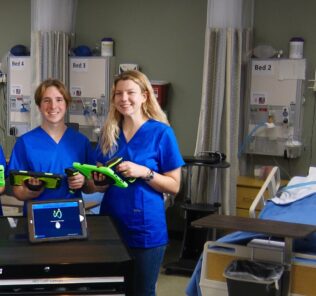A Healthcare Simulation Perspective: Tanner’s Clinical Judgement Model
Strong clinical judgment is an incredibly important characteristic across healthcare simulation, as both educators and learners depend on the accumulation of knowledge and skills over time. To make certain that sound clinical judgment is reached, Christine A. Tanner, Ph.D., RN, developed a model of clinical judgment that was published in her 2006 article “Thinking like a Nurse: A Research-Based Model of Clinical Judgment.” For this article, she reviewed almost 200 articles on clinical judgment and then presented an alternative model (the “Tanner Model”) of clinical judgment based on these studies. This HealthySimulation.com article shares how this model relates to healthcare simulation and provides examples of clinical simulation research demonstrating this notion.
From Tanner’s study review, she was able to draw five conclusions (1). The first was that five clinical judgments are more influenced by what nurses bring to the situation than the objective data about the situation at hand. The second was that sound clinical judgment rests to some degree on knowing the patient and his or her typical pattern of responses, as well as an engagement with the patient and his or her concerns. Third, Tanner concluded that clinical judgments are influenced by the context in which the situation occurs and the culture of the nursing care unit.
Her next conclusion was that nurses use a variety of reasoning patterns alone or in combination. Lastly, she shared that reflection on practice is often triggered by a breakdown in clinical judgment and is critical for the development of clinical knowledge and improvement in clinical reasoning. Overall, a model based on these general conclusions was needed to better emphasize the role of nurses’ background, the context of the situation, and nurses’ relationship with their patients, according to Tanner. She explained that such a model was central to what nurses notice and how they interpret findings, respond, and reflect on their responses.
Sponsored Content:
Based on these conclusions, one should understand that clinical judgment is needed across the medical simulation field so that learners are able to complete safe practice, and so that educators understand how to most effectively teach and develop their curricula. By applying Tanner’s Model within a healthcare simulation program setting, nursing simulation educators and their learners can work to better identify and act on the reasoning steps a nurse should utilize to make correct clinical judgment decisions.
“Thinking like a nurse, as described by this model, is a form of engaged moral reasoning. Expert nurses enter the care of particular patients with a fundamental sense of what is good and right and a vision for what makes exquisite care,” Tanner writes in her article. “Educational practices must, therefore, help students engage with patients and act on a responsible vision for excellent care of those patients and with a deep concern for the patients’ and families’ well-being.”
Healthcare Simulation / Tanner’s Clinical Judgement Model Research Articles
Nursing Students’ Clinical Judgment Skills in Simulation: Using Tanner’s Clinical Judgment Model (EJ Kim): The purpose of this study was to evaluate the nursing students’ clinical judgment skills in simulation using Tanner’s Clinical Judgment Model. This evaluation was achieved when 45 teams of a total 93 nursing students participated in a post-operative patient care scenario using a human patient simulator. Data were collected from students’ responses in the scenario and guided reflective journaling according to the framework of Tanner’s model which comprised noticing, interpreting, responding, and reflecting on response. Data were analyzed using descriptive statistics.
Sponsored Content:
The learners’ responses to the situation were in accordance with the goals of the scenario, i.e. relieving patient pain and preventing pulmonary complications. However, most students needed clinical cues and focused on a given clue to solve the issues. They lacked the ability to collect additional information as well as connect the relevant clues in a simulated clinical situation.
A Collaborative Project to Apply and Evaluate the Clinical Judgment Model Through Simulation (Nancy Dillard, Stephanie Sideras, Marilyn Ryan, Kay Hodson Carlton, Kathie Lasater, Linda Siktberg): As the use of simulations increases in nursing education, nurse educators are challenged to evaluate students’ clinical judgment skills. The purpose of this article is to describe faculty development in the use of the Lasater Clinical Judgment Rubric (LCJR); faculty application of LCJR in evaluating students’ clinical judgment skills during a simulation scenario; and faculty and students’ perception of transference from the simulation to the clinical setting.
Tanner’s Clinical Judgment Model was used in an assigned adult health simulation. Quantitative and qualitative data were collected from faculty and student evaluations and students’ reflective statements. Findings support the importance of simulation’s contribution to clinical judgment development. However, more work remains to improve the integration of clinical judgment and the use of a conceptual framework and evidence-based rubric.
Clinical Judgment Development: Using Simulation to Create an Assessment Rubric: Written by Kathie Lasater, EdD, RN, this research explains how clinical judgment is a skill every nurse needs, but nurse educators sometimes struggle with how to present it to students and assess it. This article describes an exploratory study that originated and pilot tested a rubric in the simulation laboratory to describe the development of clinical judgment, based on Tanner’s Clinical Judgment Model.
Correlations between Clinical Judgment and Learning Style Preferences of Nursing Students in the Simulation Room (Karin Hallin, Marie Häggström, Britt Bäckström, Lisbeth Porskrog Kristiansen): In nursing research, the term ‘clinical judgment’ is synonymous with critical thinking, decision making and clinical reasoning (Tanner, 2006). Clinical judgment is one of the utmost essential skills for nurses to master in order to achieve the quality of nursing required. Tanner’s Clinical Judgment Model (CJM), with the four dimensions of noticing, interpreting, responding, and reflecting, describes nurses’ thinking and decision processes when they face complex care situations. In order to serve as a guide in the identification and analysis of nursing students’ skills and behavior and to help students to diagnose failures, Lasater (2007) has developed the Clinical Judgment Rubric (LCJR) tool, on which students can be assessed as a meaningful whole.
More Healthcare Simulation Research
Reference:
Tanner, C. A. (2006). Thinking like a nurse: A research-based model of clinical judgment in nursing. Journal of Nursing Education, 45(6), 204–211.
Lance Baily, BA, EMT-B, is the Founder & CEO of HealthySimulation.com, which he started while serving as the Director of the Nevada System of Higher Education’s Clinical Simulation Center of Las Vegas back in 2010. Lance is also the Founder and acting Advisor to the Board of SimGHOSTS.org, the world’s only non-profit organization dedicated to supporting professionals operating healthcare simulation technologies. His co-edited Book: “Comprehensive Healthcare Simulation: Operations, Technology, and Innovative Practice” is cited as a key source for professional certification in the industry. Lance’s background also includes serving as a Simulation Technology Specialist for the LA Community College District, EMS fire fighting, Hollywood movie production, rescue diving, and global travel. He and his wife Abigail Baily, PhD live in Las Vegas, Nevada with their two amazing daughters.
Sponsored Content:




















